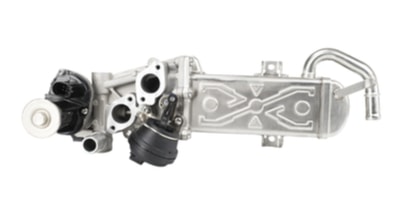The EGR valve allows a certain amount of exhaust gases to circulate from the exhaust side to the intake side. The inert, oxygen-depleted exhaust gases are used to cool the combustion chambers, reduce emissions, and improve the operating efficiency of a gas engine.
Modern EGR valves use a “stepper motor” to operate. Rather than simply being open or closed, the valve opens whatever amount the PCM determines is required for optimal engine operation.
The EGR valve is closed while the engine is warming up, and closed when under full throttle. However, it opens varying amounts for the rest of the time under normal operation.
Usually, the EGR valve is easy to access and is most often located near the intake on the top of the engine. There will be a pipe running from the exhaust to the EGR valve which is ported to the valve which usually bolts to an opening in the cast intake manifold or cylinder head.
As a part of the emission system, the EGR system has to be operational and capable of completing a self-diagnostic to pass inspection in most areas.
Cost of EGR Valve Replacement
To illustrate, below are some estimates on the EGR valve replacement cost for some common vehicles using a labor rate of $100 per hour:
For a 2010 Dodge Journey with a 3.5-liter engine, the labor time is estimated at 0.5 of an hour. A factory EGR valve costs about $200 and an Airtex replacement part is about $85. The total cost to complete the job is about $250 using OE parts and about $135 using aftermarket parts.
For a 2003 Toyota Camry with a 3.0-liter engine, the labor time is estimated at 0.7 of an hour. A factory EGR valve is about $313 and a WVE replacement part is about $107. The total cost to complete the job is about $383 using OE parts and about $187 using aftermarket parts.
For a 2006 Volkswagen Golf with a 2.0-liter engine, the labor time is estimated at 0.5 of an hour. A factory EGR valve cost is about $509 and an Airtex replacement part is about $177. The total cost to complete the job is about $559 using factory parts and about $227 using aftermarket parts.
For a 2000 Ford Explorer with a 4.0-liter engine, the labor time is estimated at 0.5 of an hour. A factory EGR valve is about $98 and a Standard replacement part is about $50. The total cost to complete the job is about $148 using factory parts and about $100 using aftermarket parts.
Why EGR Valve is Important?
The main exhaust gases that the EGR valve serves to reduce are nitrogen oxides. Nitrogen oxides are pollutants, causing eye and lung irritation, and are a main ingredient of the brown haze we call “smog”.
Nitrogen oxides form during high-temperature combustion and the EGR system decreases these by reducing the engine’s combustion chamber temperatures.

Other benefits of a lower combustion chamber temperature are less heat stress on the valves and the engine generally has more complete combustion and has better fuel efficiency. They also include the ability of the engine to run advanced timing without pre-ignition or ping.
What Else Can Go Wrong?
As the EGR valve circulates a stream of fairly dirty exhaust gases, it is prone to failure from heat cycling and soot deposits. Sometimes the pipe that directs exhaust gases to the EGR valve can become clogged with soot and the intake passages the valve feeds gas to can become clogged with soot.
Both can usually be cleaned, but not always without some effort. Sometimes, a clogged intake needs to be removed and cleaned manually on a bench.
Modern EGR valves have several self-diagnostic features. There is a built-in sensor that measures how far the valve opens.
If that doesn’t agree with how far the PCM has directed it to open, code and the engine light is set. The PCM can also sense if the motor isn’t drawing as much current as it should.
In this case, it will set a code for a circuit fault. Either of these codes can simply indicate what they are intended to, but wiring issues can also mimic the same problems.
On modern vehicles as well, the PCM looks at the engine vacuum and will set a code if it doesn’t see the expected vacuum response to an EGR command. Older style EGR systems used vacuum valves to operate the EGR.
In either case, a problem in the vacuum system could lead to a problem or the appearance of a problem in the EGR system.

